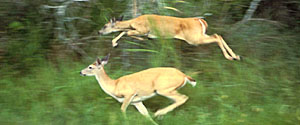Columbian white-tailed deer facts for kids
Quick facts for kids Columbian white-tailed deer |
|
|---|---|
 |
|
| Conservation status | |
| Scientific classification |
|
| Kingdom: | Animalia |
| Phylum: | Chordata |
| Class: | Mammalia |
| Order: | Artiodactyla |
| Family: | Cervidae |
| Subfamily: | Capreolinae |
| Genus: | Odocoileus |
| Species: | |
| Subspecies: |
O. v. leucurus
|
| Trinomial name | |
| Odocoileus virginianus leucurus (Douglas, 1829)
|
|
The Columbian white-tailed deer (Odocoileus virginianus leucurus) is a special type of white-tailed deer. It is one of many different kinds, or subspecies, of white-tailed deer found in North America. This deer belongs to the Cervidae family. Other animals in this family include mule deer, elk, moose, caribou, and the black-tailed deer.
Contents
Where Do Columbian White-Tailed Deer Live?
The Columbian white-tailed deer gets its name from the Columbia River. This river flows through Oregon and Washington. These deer gather in areas along the lower Columbia River. You can find them on islands in Clatsop and Columbia counties in Oregon. They also live in Wahkiakum County, Washington. Other groups of these deer live in the Umpqua River basin.
What Kind of Habitat Do They Like?
These deer usually live near rivers and streams. These areas are called riparian zones. They also like brushy woodlands. These woods often have cottonwood, willow, alder, spruce, and dogwood trees.
How Do Columbian White-Tailed Deer Have Babies?
Female Columbian white-tailed deer are different from other white-tailed deer. Most white-tailed deer can have babies when they are about six months old. But female Columbian white-tailed deer usually wait until they are about 18 months old. They commonly have only one fawn (baby deer) at a time. Male deer, called bucks, can also breed when they are about 18 months old.
Protecting the Columbian White-Tailed Deer
The Columbian white-tailed deer was listed as an endangered species in 1967. This meant it was in danger of disappearing forever. In 1978, the Endangered Species Act officially recognized it as endangered. This act helps protect animals that are at risk.
Efforts to Save the Deer
For many years, people worked hard to save these deer. The Oregon Department of Fish and Wildlife Service and the Bureau of Land Management helped a lot. Their efforts paid off for some deer. On July 24, 2003, the deer population in Douglas County, Oregon was removed from the Endangered Species Act. This was great news! Their numbers grew from about 2,500 in the early 1980s to over 6,000 today.
Are All Columbian White-Tailed Deer Safe Now?
Even though some deer populations are doing better, the Columbian white-tailed deer is still on the Endangered Species Act overall. This means they still need protection. For over 20 years, hunting these deer was mostly not allowed. However, in 2005, some hunting permits were given out for the Umpqua River area.
A Special Home for the Deer
The Julia Butler Hansen Refuge for the Columbian White-Tailed Deer is a very important place. It is located in Cathlamet, Washington. This refuge helps protect the deer's natural home. About 300 Columbian white-tailed deer live safely on this refuge today.
In April 2012, there was a threat to the deer at the refuge. High river levels and a collapsing dike (a wall that keeps the river from flooding) put the deer in danger. People worked to fix this problem and keep the deer safe.


